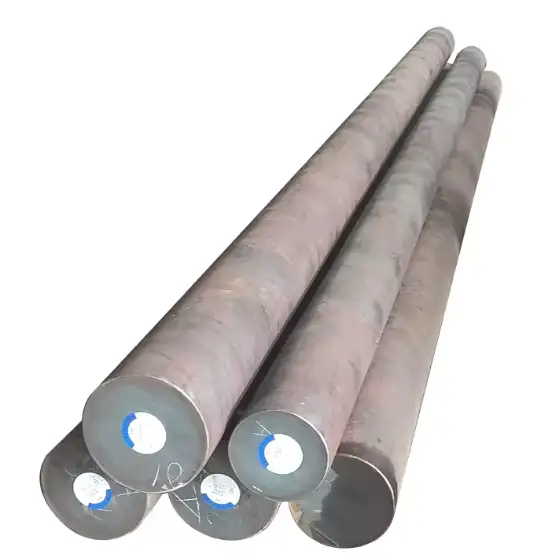ASTM A572 Grade 50 round bar is a high-strength, low-alloy (HSLA) structural steel that delivers a minimum yield of 50 ksi (345 MPa) and minimum ultimate tensile strength of 65 ksi (≈450 MPa). For structural applications where higher strength, improved strength-to-weight ratio, reliable weldability, and consistent toughness are required, A572 Gr 50 round bar is usually preferable to plain carbon steels such as ASTM A36. MWalloys supplies A572 Gr 50 round bar from our factory stock in China at competitive, mill-direct pricing with fast lead times for standard diameters and OEM cut lengths.
What is ASTM A572 Grade 50?
ASTM A572/A572M is the ASTM standard for high-strength, low-alloy columbium-vanadium structural steel. Grade 50 indicates the minimum yield strength of 50 ksi (≈345 MPa) at room temperature. The specification covers shapes, plates, sheet piling, and bars intended for riveted, bolted, or welded construction. The grade is a common choice when higher strength is wanted without adding heavy mass.
A572 Gr 50 vs ASTM A36 comparison
• Yield strength: A36 — min 36 ksi (≈250 MPa); A572 Gr 50 — min 50 ksi (≈345 MPa).
• Tensile strength: A36 typical ultimate ~58–80 ksi depending on product form; A572 Gr 50 typical ultimate ≈65 ksi (≈450 MPa).
• Alloying: A572 contains controlled amounts of alloying elements (columbium/vanadium optional) that improve strength and toughness while retaining good weldability; A36 is a plain carbon structural steel with lower strength.
• Use case: Use A572 Gr 50 when weight reduction and higher factor of safety are design drivers; use A36 for general structural components where higher thickness, availability, or lower cost matters.
Chemical composition
The table below shows commonly quoted maximum values from the ASTM A572 specification and widely accepted mill practice. Minor variations occur depending on product form (bar vs plate), thickness and producer; always confirm with the mill certificate.
| Element | Maximum (typical) |
|---|---|
| Carbon (C) | 0.23% (max) |
| Manganese (Mn) | 1.35% (max) |
| Phosphorus (P) | 0.040% (max) |
| Sulfur (S) | 0.050% (max). (many mills quote 0.03% for plate) |
| Silicon (Si) | 0.15–0.40% (thickness dependent) |
| Columbium (Nb), Vanadium (V) | Small controlled amounts permitted / specified for grain control (per ASTM) |
| Copper (Cu) | Optional additions in some mill variants (trace) |
Note: the ASTM standard includes requirements for columbium/vanadium and optional limits for copper or other microalloying elements when they are used to obtain the required mechanical properties. For final chemistry accept certificates of analysis (COA) from the mill.
Mechanical / material properties (typical for A572 Grade 50)
| Property | Typical / Minimum |
|---|---|
| Minimum yield strength (σ<sub>y</sub>) | 345 MPa (50 ksi) |
| Typical ultimate tensile strength (σ<sub>u</sub>) | ≈450 MPa (65 ksi) |
| Elongation (A<sub>200mm</sub>) | ≥ 18% (200 mm gauge) typical |
| Elongation (A<sub>50mm</sub>) | ≥ 21% (50 mm gauge) typical |
| Brinell Hardness (approx.) | ~130–140 HB (varies with thermo-mechanical processing) |
| Modulus of Elasticity (E) | ≈ 200 GPa (29,000 ksi) |
These values reflect standard mill practice for hot-rolled HSLA steels meeting A572 Grade 50. Project or regional codes may impose additional testing (impact toughness at low temperature, CEV limits for welding, nondestructive testing).
A572 Gr 50 round bar — typical specification and acceptance criteria
| Item | Requirement / Typical |
|---|---|
| Standard | ASTM A572 / A572M (current edition), product form: round bar. |
| Diameter range (typical stock) | From small diameters (~6–12 mm) up to 100 mm and larger from special orders; common stock: 10–100 mm (⅜"–4"). |
| Lengths | Mill lengths (3–6 m) or cut-to-length per order. |
| Surface finish | Hot-rolled, pickled, shot blasted optional. |
| Heat treatment | Normal hot-rolled condition; normalizing optional for specific toughness needs. |
| Certification | Mill test report (EN 10204 3.1 or 2.2 depending on buyer requirements). |
| Tolerances | Manufacturer’s standard tolerances for diameter, straightness and surface defects; tighter tolerances by agreement. |
Always specify required certificate type, inspection points and weldability/toughness needs in the purchase order.
What is A572 Gr 50 round bar used for?
A non-exhaustive list that reflects industry practice: structural bolts and pins, shafts for light fabrication, machined components in construction equipment, fabricated building elements (gusset plates, brackets), highway hardware, reinforcement parts for trailers and lifts, and general structural components where higher yield strength is required but formability and weldability must remain good. In many bridge and building projects, thinner sections of A572 Gr 50 replace thicker A36 parts to save weight.
Equivalent grades and international cross-references
• Europe: EN 10025 S355 (S355JR / S355J2 variants) is often treated as the closest European equivalent to A572 Grade 50 for many structural applications; slight chemistry and impact specifications vary, so consult project codes before substitution.
• China: Q355B / Q355C are commonly offered Chinese equivalents for structural HSLA steels. Confirm mill certificates and impact requirements.
• Other US grades with 50 ksi yield: ASTM A529 Gr 50, ASTM A992 (for shapes) have similar minimum strength requirements; selection depends on product form and application.
Sizes and weight
Method (imperial): weight (lb/ft) = (π / 4) × d² (in²) × density (lb/in³) × 12 in/ft. Using density = 0.284 lb/in³ gives a constant: weight (lb/ft) ≈ 2.67663694 × d² (in²). This is the industry formula used for solid round bars. Engineering Toolbox documents the same density and calculation approach.
Method (metric): weight (kg/m) = (π / 4) × (d_mm² / 1,000,000) × 7850 (kg/m³) ≈ 0.006165376 × d_mm² (kg/m). Engineering Toolbox uses density 7850 kg/m³ for solid steel calculations.
Quick reference — common diameters
| Diameter (mm) | Weight (kg/m) | Diameter (in) | Weight (lb/ft) |
|---|---|---|---|
| 10 mm | 0.617 kg/m | 0.394" | 0.415 lb/ft |
| 12 mm | 0.888 kg/m | 0.472" | 0.597 lb/ft |
| 16 mm | 1.578 kg/m | 0.630" | 1.062 lb/ft |
| 20 mm | 2.466 kg/m | 0.787" | 1.660 lb/ft |
| 25 mm | 3.853 kg/m | 0.984" | 2.593 lb/ft |
| 30 mm | 5.549 kg/m | 1.181" | 3.734 lb/ft |
| 40 mm | 9.865 kg/m | 1.575" | 6.638 lb/ft |
| 50 mm | 15.413 kg/m | 1.969" | 10.372 lb/ft |
| 60 mm | 22.195 kg/m | 2.362" | 14.936 lb/ft |
| 75 mm | 34.680 kg/m | 2.953" | 23.337 lb/ft |
| 100 mm | 61.654 kg/m | 3.937" | 41.488 lb/ft |
(Values computed from the solid bar formula with density = 7850 kg/m³; rounded to 3 decimals.)
Manufacturing, welding, forming, and QC notes
• Manufacturing: hot rolling is the typical production route for round bar. Mill procedures for controlled rolling and accelerated cooling improve strength and toughness. ASTM A572 requires control of specific alloying additions when used.
• Welding: A572 Gr 50 is generally weldable by typical processes (SMAW, GMAW, FCAW). Watch carbon equivalent (CEV) for thicker sections to prevent cold cracking; preheat and qualified procedures may be necessary for critical fabrications.
• Forming & machining: cold bending and light forming are possible on smaller bars; machining is moderate — tool selection and feeds should reflect higher strength.
• Quality control: request mill test certificate (MTC) type EN 10204 3.1 for critical projects; specify Charpy impact tests if the part will see low-temperature service.
Advantages and limitations
Advantages: higher yield strength reduces section size; good weldability; consistent mechanical performance; broad international availability.
Limitations: higher mill cost versus A36 for identical volumes; some project specifications require S355 or other EN grades with specific impact requirements; A572 Gr 50 may need special attention for low-temperature toughness if that service condition applies. Always check project codes.
Price comparison (2025 snapshot) — USA, Europe, China
Important note: steel prices are volatile in 2025 due to regional policy moves, tariff developments and global scrap/coil supply changes. The ranges below are compiled from market price services and industry reporting; they should be treated as indicative. Always get a mill or distributor quote for firm pricing.
USA (2025, indicative mill/distributor price for structural HSLA plate/long products)
Range: ≈ USD 750 – 1,100 per metric ton for A572-type hot-rolled material (mill pick, plain finish); tariffs or domestic mills’ announcements may raise effective delivered costs. Recent supply responses and tariff policy have pushed domestic prices above world averages in some months.
Europe (2025, indicative delivered)
Range: ≈ EUR 600 – 900 per metric ton depending on product, regional logistics, and thickness; MEPS and Fastmarkets provide subscriptions for up-to-date indices. European spot levels generally track MEPS indices.
China (2025, indicative mill price FOB)
Range: ≈ USD 450 – 800 per metric ton for hot-rolled structural product from Chinese mills in the spot market; domestic oversupply or policy changes may push the low end of the range lower, but export volumes and duties change delivered cost. Trading Economics, MEPS and SteelBenchmarker publish regional indices.
How to interpret these numbers: local taxes, freight, quality grade, thickness, cut-to-length, galvanizing or further processing, and certification level (EN 10204 3.1 vs. 2.2) materially affect landed price. For accurate cost comparisons, request a mill quote including freight and customs.
How MWalloys supplies A572 Gr 50 round bar
MWalloys offers factory-direct supply of A572 Grade 50 round bar from our production partners in China. Key selling points:
-
100% factory pricing for bulk buyers, saving the middle margin present in some trader quotes.
-
Stock availability for common diameters (10–100 mm) with fast cut-to-length service; ideal for projects with short lead times.
-
Certificates: we provide mill test reports (MTC) and can supply EN 10204 3.1 on request for structural projects.
-
QC & inspection: third-party inspection and weld procedure documentation available for critical contracts.
Contact our sales team with diameter, quantity, certification and delivery port for an immediate firm quotation.
FAQs
-
Is A572 Gr 50 magnetic?
Yes. A572 is a carbon/low-alloy steel and is ferromagnetic. -
Can I weld A572 Gr 50 to A36?
Yes. These steels can be joined, but check weld procedure and preheat for thicker sections; avoid mismatching properties in highly stressed connections. -
Is A572 Gr 50 the same as S355?
They are close equivalents in strength and many uses, but chemistry, impact tests and delivery requirements differ; confirm acceptance with project specifications before substitution. -
What certificates should I request?
Ask for an MTC (EN 10204) — 3.1 for mill chemical/mechanical test certs when project quality traceability is required. -
Can A572 Gr 50 round bar be heat treated to improve properties?
Hot-rolled A572 is supplied in the as-rolled condition; normalizing is possible but not common for standard structural bar. Consult the mill for heat-treatment options. -
Is A572 Gr 50 suitable for low temperature applications?
Standard A572 may not meet defined low-temperature impact values unless the specific product has been ordered with Charpy impact tests and passing results; specify temperature and testing when ordering. -
What is the carbon equivalent (CE) for A572 Gr 50?
CE varies with exact chemistry; mills publish CE in the MTC. For welding procedure qualification, use the value supplied by the mill. -
Which finish options are common?
Hot-rolled plain, pickled, shot-blasted, or painted; galvanizing done on request for corrosion resistance. -
How fast can MWalloys deliver from stock?
For stocked diameters we typically ship within days for standard container quantities; lead time for large bespoke quantities depends on mill schedules. -
Do you provide machining or secondary services?
Yes; we can arrange cutting, drilling, threading or light machining under contract and provide packaging for export.
Authoritative references
-
- ASTM A572/A572M — Standard Specification for High-Strength Low-Alloy Columbium-Vanadium Structural Steel
- American Institute of Steel Construction (AISC) — technical guidance and Steel Construction Manual resources
- BS EN 10025-2 (via BSI) — Hot rolled products of structural steels (S355 family, technical delivery conditions)





